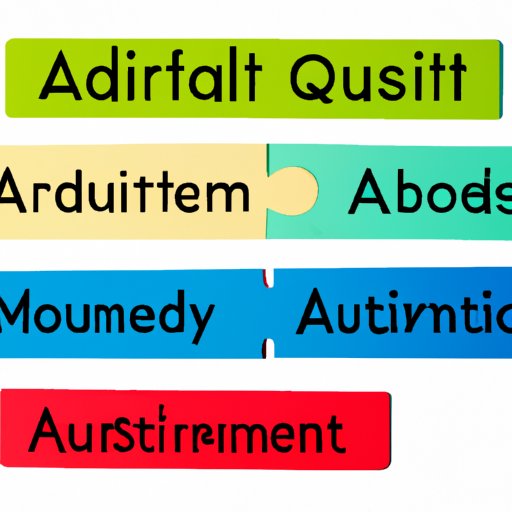
I. Introduction
It is not uncommon for individuals to have both Attention-Deficit/Hyperactivity Disorder (ADHD) and Autism Spectrum Disorder (ASD). However, the presence of overlapping symptoms in both conditions can make the diagnosis challenging. In this article, we will explore the overlapping symptoms, diagnosis challenges, personal accounts, and management strategies for those living with both conditions.
II. ADHD and Autism: Overlapping Symptoms and Diagnosis Challenges
ADHD and autism have some similarities but are also different conditions. According to the Diagnostic and Statistical Manual of Mental Disorders (DSM-5), individuals with ADHD often display hyperactivity, impulsivity, and/or inattention whereas individuals with autism display deficits in social communication and interaction, as well as restricted or repetitive behaviors or interests.
However, the symptoms of ADHD and autism can overlap, making it challenging to diagnose either condition. For instance, individuals with ADHD and autism may struggle with social communication, sensory sensitivities, executive functioning difficulties, and language impairments.
III. Understanding Comorbidity: Exploring the Link between ADHD and Autism
Comorbidity is the occurrence of two or more conditions in an individual. Individuals with ADHD are at a higher risk of having comorbid conditions such as anxiety, depression, and autism.
The prevalence of comorbidity in individuals with ADHD and autism is significant, ranging from 20% to 50%. The reasons for this are unknown, but research suggests that both genetic and environmental factors may contribute to comorbidity.
IV. Living with Both: A Personal Account of Coping with ADHD and Autism
Living with both ADHD and autism can be challenging. Individuals who have both conditions may face difficulties with executive functioning, social interaction, sensory processing, and emotional regulation.
Here is a personal account from John, who has been diagnosed with both ADHD and autism :
“Having both ADHD and autism has been a challenge throughout my life. I struggle with planning and completing tasks, and often become easily distracted. Additionally, I have difficulty with social interactions and find it challenging to pick up on social cues. There are times when I experience sensory sensitivities where I feel overwhelmed by noise or certain textures. However, with the support of family, friends, and healthcare professionals, I have developed strategies to help manage these challenges and focus on my strengths.”
John’s story highlights the importance of recognizing that individuals with ADHD and autism are unique and require different types of support and guidance.
V. Managing ADHD and Autism in Children: Strategies for Parents and Educators
It is vital for parents and educators to work together to ensure the child receives the appropriate support and resources to manage both ADHD and autism.
Some strategies include:
- Providing structure and routine to the child’s daily life
- Using visual aids to help with communication and understanding
- Creating a calm and sensory-friendly environment
- Breaking down tasks into smaller steps to make them more manageable
- Using positive reinforcement to encourage desired behavior
It is essential for parents and educators to work with healthcare professionals to develop an individualized treatment plan for the child.
VI. ADHD or Autism? Differentiating Symptoms and Seeking Professional Help
Getting a proper diagnosis is vital for individuals with ADHD, autism, or both. It is essential to seek professional help from healthcare professionals and specialists who are experienced in diagnosing and treating these conditions.
Here are some guidelines to differentiate the symptoms of ADHD and autism:
- ADHD – hyperactivity, impulsivity, inattention
- Autism – deficits in social communication and interaction, restricted or repetitive behaviors or interests
Individuals who suspect they or someone they know may have ADHD, autism, or both, should seek professional help as soon as possible.
VII. ADHD and Autism Spectrum Disorder: Current Research and Treatment Approaches
Recent research suggests that individuals with ADHD and autism have similar genetic and environmental factors that may contribute to both conditions. For example, research indicates that prenatal exposure to toxins, such as lead or mercury, can increase the risk of developing both conditions.
There are various treatment approaches that may help manage symptoms of both ADHD and autism. These include medication, behavioral therapy, occupational therapy, and speech therapy, among others. Emerging treatments, such as neurofeedback and cognitive-behavioral therapy, show some promise for individuals with both conditions.
VIII. Conclusion
Individuals with both ADHD and autism face unique challenges that require different types of support and management strategies. Although both conditions may present similar symptoms, a proper diagnosis and effective treatment plan can help individuals manage their symptoms and lead fulfilling lives.
If you or someone you know may have ADHD, autism, or both, seek professional help and resources as soon as possible. Together, we can provide the support and guidance needed for individuals living with both conditions.




